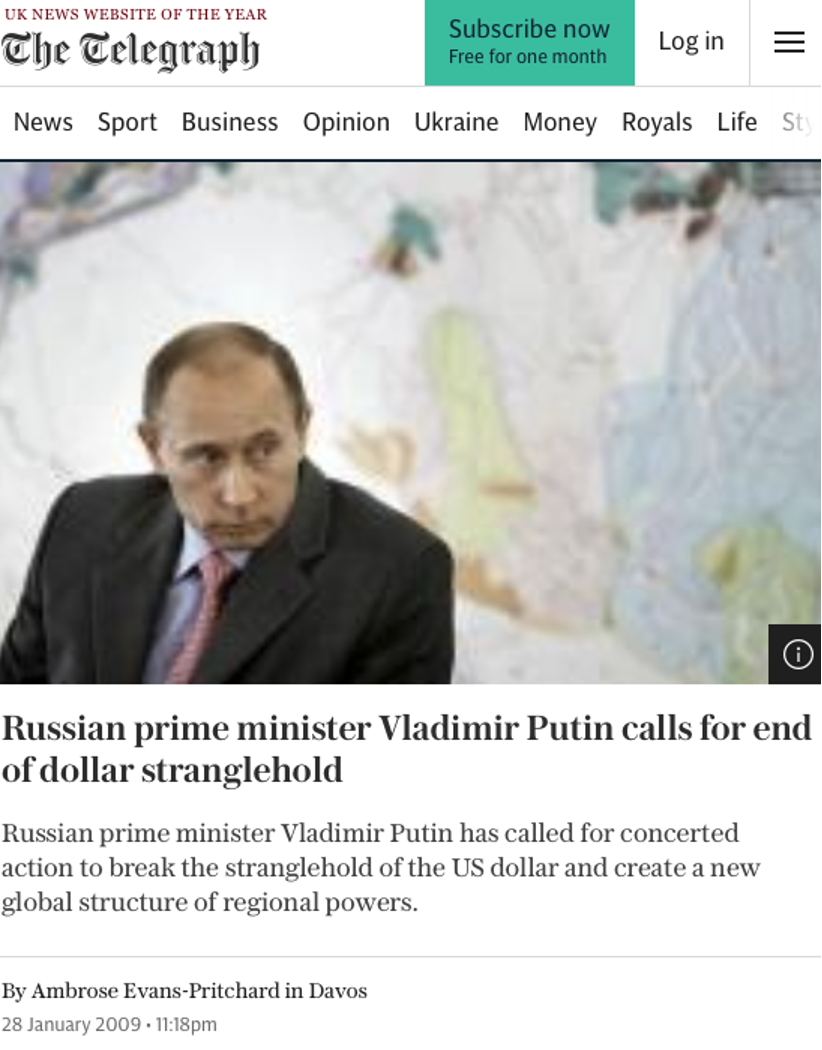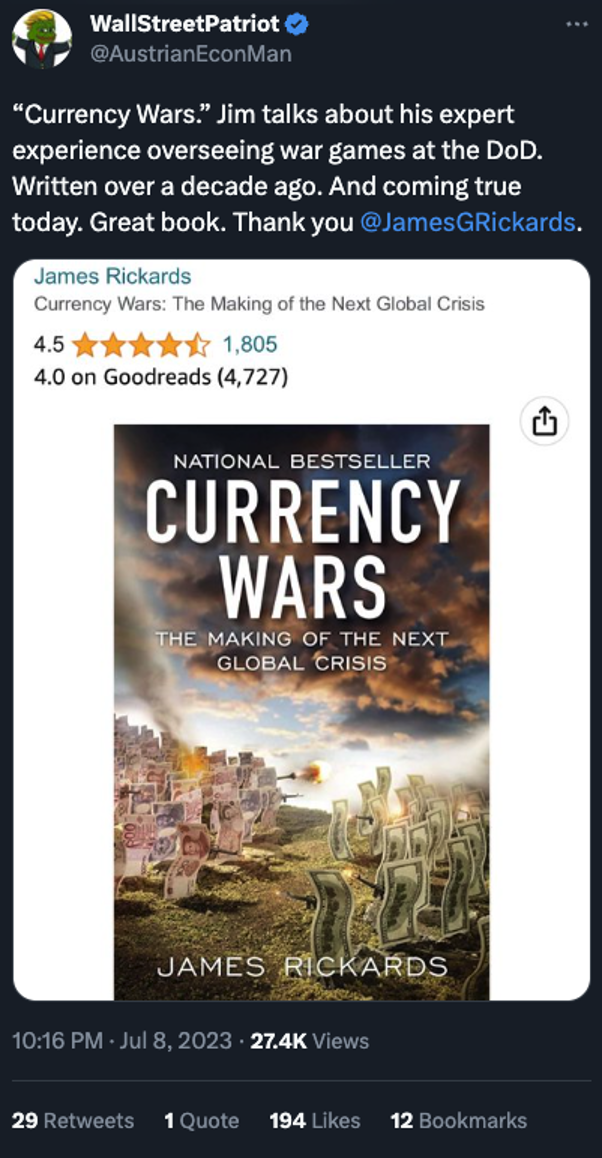Financial War Games
- You can’t say Putin didn’t warn us
- Inflation: As good as it gets (continued)
- Like a bad memory from the forever wars
- Nice solar farm you’ve got there, be a shame if…
- Mailbag: Student debt and China’s head start
![]() You Can’t Say Putin Didn’t Warn Us
You Can’t Say Putin Didn’t Warn Us
 “Isn’t it clear? They’re destroying the dollar with their own hands.”
“Isn’t it clear? They’re destroying the dollar with their own hands.”
That’s what Russia’s president Vladimir Putin said about American leaders.
In 2019.
At the time, there was a certain amount of exaggeration surrounding those remarks on social media. (Shocking, right?) But assuming the English-language subtitles accompanying a video clip were accurate, here’s what Putin said in 38 seconds…
The dollar enjoyed great trust around the world. It was almost the only universal currency in the world. For some reason, the U.S. began to use dollar settlements as a tool for political struggle, imposing restrictions on the use of the dollars. They began to bite the hand that feeds them. They’ll collapse soon.
Many countries in the world began turning away from using the dollar as a reserve currency. They restrict Iran in its dollar settlements. They impose some restrictions on Russia and other countries. This undermines confidence in the dollar. Isn’t it clear? They’re destroying the dollar with their own hands.
Again, this is late 2019 — more than two years before Russia’s invasion of Ukraine in early 2022.
Two days after the tanks rolled in, Washington froze the assets of Russia’s central bank — a step so reckless that it prompted leaders in dozens of other countries to wonder if they might be next.
Since then, their efforts to get out from under the dollar’s thumb are such that talk of “de-dollarization” has finally made it into mainstream financial media here in 2023.
 Now, chew on an even earlier Putin quotation: “The one reserve currency has become a danger to the world economy: That is now obvious to everybody.”
Now, chew on an even earlier Putin quotation: “The one reserve currency has become a danger to the world economy: That is now obvious to everybody.”
This is from 2009. Amazingly, he said it at the World Economic Forum in Davos, Switzerland — long before he became persona non grata among Western elites. Note the date at the bottom of this screengrab…

 As it happens, Putin’s 2009 statement occurred on the second and final day of the Pentagon’s first-ever “financial war game.”
As it happens, Putin’s 2009 statement occurred on the second and final day of the Pentagon’s first-ever “financial war game.”
Held at the Warfare Analysis Laboratory in Laurel, Maryland, Paradigm’s own Jim Rickards walked senior military planners through a two-day exercise. He tells the whole story in the opening chapters of his 2011 book, Currency Wars. Even now, readers shower that volume with praise…

The atmosphere was tense on that January day in 2009. Outside the strategy room, the global financial crisis still raged. The banking system was in shambles and the U.S. stock market was still weeks away from finding a bottom.
We won’t give too much away here; suffice it to say Team Russia announced it would accept only gold in exchange for its oil and gas — no dollars. Then Team China made its own move to, as Jim wrote, “tighten the noose around the U.S. dollar’s neck.”
Spooky, huh?
No, not everything is playing out in 2023 exactly the way he envisioned it 14 years earlier. But that’s not the point.
 The point is that while the Davos crowd was waving off Putin’s warnings in 2009, Jim understood the scope of the threat facing the dollar.
The point is that while the Davos crowd was waving off Putin’s warnings in 2009, Jim understood the scope of the threat facing the dollar.
Now, amid a hot war in Ukraine, and the BRICS nations scheming on a system to challenge the dollar… Jim has decided it’s time to deliver a “Part 2” of his briefing — not to Pentagon brass, but to you.
Next week, Jim invites you to an exclusive online event from the Pentagon City complex in Virginia — based in part on information he’s previously shared behind closed doors at the CIA and the Office of Net Assessment, the most secure room inside the Pentagon.
“This briefing has the potential to be the most consequential update for you and your finances that I’ve ever given,” he promises. It’s set for this coming Tuesday, July 18 at 6:45 p.m. EDT.
Because of the sensitive nature of the information, he’s asking that you submit a “clearance form” in advance. All you need to do is follow this link to register, and answer three simple questions on the form.
![]() Inflation: As Good as It Gets (Cont’d)
Inflation: As Good as It Gets (Cont’d)
 A titan of finance is reinforcing the suspicions we shared here Wednesday: Inflation has bottomed for now.
A titan of finance is reinforcing the suspicions we shared here Wednesday: Inflation has bottomed for now.
“Inflation has come down but it is still too high,” says Bob Prince, co-investment chief of the $125-billion strong Bridgewater Associates. “It is probably going to level out where it is — we’re likely to be stuck around this level of inflation,” he tells the Financial Times.
As a reminder, the official inflation rate clocked in this week at 3% — down from 9.1% a year ago, but still not back to the Federal Reserve’s long-term target of 2%. As we demonstrated in our Independence Day edition, research shows once inflation soars over 5%, it typically takes a decade to get back to 2%.
But the betting in the futures market is that inflation has been tamed, the Fed will be done raising interest rates after this month… and that the Fed will cut rates as many as six times next year.
Prince isn’t buying it: “The Fed is not going to cut. They are not going to do what is priced in[to the market].”
 But for the moment, the major U.S. stock indexes are once more in the green today. At last check, the S&P 500 is up a modest seven points on the day to 4,517. The Dow and the Nasdaq are both looking a little perkier.
But for the moment, the major U.S. stock indexes are once more in the green today. At last check, the S&P 500 is up a modest seven points on the day to 4,517. The Dow and the Nasdaq are both looking a little perkier.
The dollar index has stabilized after a free fall the last couple days, now 99.9, but Paradigm trading authority Alan Knuckman is looking for still more dollar downside — which means more upside for stocks and a boost to commodities.
“This bust in the dollar is going to be very beneficial and bullish for everything,” he tells readers of The Profit Wire. “So [until this week] we've been trading between 105 and 100 now for six months. A breakdown targets 95 on the downside and that's a positive for stocks.”
Meanwhile, earnings season is formally underway, with JPMorgan Chase and Citigroup both beating the expectations of Wall Street analysts. But Citi is nonetheless getting punished by traders for declines in both earnings and revenue; C shares are down 1.5% as we write, while JPM is up a half percent.
Gold is edging down to $1,955 but silver is only eight cents away from $25. Crude has eased over a buck to $75.66. Bitcoin is playing catch-up to most other asset classes this week — rallying this morning past $31,000.
 This is your friendly reminder the UPS strike still looms, and time to reach agreement has effectively run out.
This is your friendly reminder the UPS strike still looms, and time to reach agreement has effectively run out.
Yes, the media is all about the Hollywood strike today… but the Anderson Economic Group is warning that a UPS strike would be “one of the costliest in at least a century” — a $7 billion drag on the economy if it goes on for 10 days. That includes $4 billion in losses by UPS customers.
UPS and the Teamsters aren’t talking right now, and the current contract expires at the end of this month. But as Paradigm’s Dan Amoss reminded us a few days ago, the real deadline is right about now — because union leadership always needs time to sell the rank-and-file on whatever agreement is hammered out.
Could get messy, and it’s not just about the junk you order from Amazon: The Anderson Economic Group study says the entire domestic supply chain that’s only now recovered from the 2020 lockdowns could get all bollixed up again.
![]() Like a Bad Memory From the Forever Wars
Like a Bad Memory From the Forever Wars
 Turning to geopolitics, we see the war in Ukraine has spurred the U.S. government to reinstate “the backdoor draft.”
Turning to geopolitics, we see the war in Ukraine has spurred the U.S. government to reinstate “the backdoor draft.”
Recall that during the early years of the Iraq and Afghanistan wars, active-duty troops were forced to stay in the military beyond their scheduled hitch — while reserve forces were stretched to their limits and the National Guard was stretched beyond its limits.

Last night around dinnertime on the East Coast, Joe Biden coughed out an executive order: He’s activating 3,000 reservists for deployment to Europe.
Since Russia invaded Ukraine last year, Washington has upped the number of U.S. troops in Europe by roughly 25% — to over 100,000 for the first time since 2005.
A spokesman for U.S. European Command says the order will “not change current force-posture levels.” That would suggest they need reservists just to keep up with the rotation of regular forces in and out of Europe.
It was a little over a year ago we speculated about an eventual return of the draft — a move that would surely have major impacts on the civilian economy.
The military’s recruitment efforts have continued to fall short of their goals since then. The Wall Street Journal had a long story a few days ago about how veterans are discouraging their kids and grandkids from enlisting — and for many years that’s been the most reliable source of new recruits.
When we broached the topic of a draft with our readership last year, the responses filled nine pages of a Word document. So we’ll ask again: Does a draft seem plausible to you? Write here, especially if you have draft-age kids or grandkids: feedback@paradigmpressroom.com
![]() Nice Solar Farm You’ve Got There. Be a Shame If…
Nice Solar Farm You’ve Got There. Be a Shame If…
 Downsides to green energy we hadn’t started thinking about yet…
Downsides to green energy we hadn’t started thinking about yet…

A hailstorm tore through the Nebraska panhandle in late June — baseball-size chunks shattering many of the panels on a 5.2-megawatt solar farm.
The Nebraska Public Power District, which buys electricity from the solar farm, is still waiting for word from the solar farm’s operator about the extent of the damage. That’s according to the Cowboy State Daily website based in next-door Wyoming.
“While some of the solar panels at the farm may be salvageable, as well as other equipment, it’s likely many of the panels will need to be discarded,” reports Cowboy State Daily’s Kevin Killough.
The polysilicon that goes into a solar panel cannot be recycled. Other materials are potentially salvageable, though not silver: “It is possible to recover aluminum and copper from a panel's frame and junction box,” Killough explains.
“The Grist, a publication of a pro-renewable nonprofit, reported that a recycled panel will produce about $3 in recovered aluminum, copper and glass, which after transportation costs will cost $12–25 to get.
“The same panel tossed into a landfill will cost less than a buck.”
Yup, that seems like the most likely destination…
![]() Mailbag: Student Debt and China’s Head Start
Mailbag: Student Debt and China’s Head Start
 “I have to weigh in on the student debt conversation,” a reader writes. “As a Gen Xer who racked up $56K between undergrad and grad school, and who paid it off in eight years, I see this one from many perspectives.
“I have to weigh in on the student debt conversation,” a reader writes. “As a Gen Xer who racked up $56K between undergrad and grad school, and who paid it off in eight years, I see this one from many perspectives.
“However, one thing I never hear discussed is student loan underwriting. Therein lie both the problem and solution.
“Student debt should be underwritten like a home mortgage based on both university performance and student grades. A bank wouldn't lend me more for a home than it is worth. Nor should they lend a student more for a degree that is unlikely to generate sufficient income to repay the loan in a reasonable time of, say, 10 years.
“If the university can provide data that corroborates their grads with degree X make enough, then students can borrow. If not, don't saddle a person with lifelong debt. It's a poor underwriting practice and universities have zero skin in the game.
“Fiscally responsible underwriting would stop excessive lending. It would also force a reckoning onto universities charging exorbitant tuition for a degree that's never likely to generate income sufficient to pay it off.
“As for current students... relief should come from university endowments... not taxpayers.”
Dave responds: Can’t find much to argue with there.
One of the news stories breaking as I write today is a new ruse by the Biden administration to forgive student loan debt — $39 billion worth, held by 800,000 borrowers.
Emily will have more about that tomorrow for our Saturday countdown edition…
 “In reading your piece Wednesday about China’s 30-year head start in strategic metals that are needed for batteries,” a reader writes, “suddenly the insanity of the green push for an impossible technology makes sense.
“In reading your piece Wednesday about China’s 30-year head start in strategic metals that are needed for batteries,” a reader writes, “suddenly the insanity of the green push for an impossible technology makes sense.
“China has been influencing the agenda to make their investment pay off.
“I would summarize this in two maxims: The best way to predict the future is to create it, and follow the money.
“Appreciate your take on things, and your continued willingness to publish reader letters from various viewpoints.”
Dave responds: There’s surely a grain of truth to what you’re saying there. All the same, I worry some folks would latch onto this set of facts and go, See, the ChiComs have a diabolical plan to undermine America and they’ve been working on it for decades!
Of course, the power elite would love nothing more than for everyday Americans to blame foreign devils for scarce and costly energy… and not the choices the elites themselves made.
Hate to end the week on a downer, but it reminds me of what Nazi Germany’s Herman Goering said to the author and psychologist Gustave Gilbert during the Nuremberg trials…
“The people can always be brought to the bidding of the leaders. That is easy. All you have to do is tell them they are being attacked and denounce the pacifists for lack of patriotism and exposing the country to danger.
“It works the same way in any country.”
Try to have a good weekend,

Dave Gonigam
Managing editor, Paradigm Pressroom's 5 Bullets










